2007’s Top Five Melanistic Deer Hot Spots
Posted by: Loren Coleman on November 28th, 2007

2007’s Top Five Melanistic Deer Hot Spots in America
by Loren Coleman, cryptozoologist and coauthor of cryptozoological field guides.
In the tradition of my list of the top places to find melanistic squirrels in 2006, here’s a list of the top locations to see black deer in 2007.
1. Texas Hill Country, Central Texas.
It has been said that the eastern edge of Texas’ Edwards Plateau region and adjacent areas of the Blackland Prairie region are the epicenter of the world’s population of melanistic white-tailed deer, for reasons not well understood by zoologists.
In going over the scientific literature, Dr. John T. Baccus and John C. Posey of Southwest Texas State University in San Marcos have been unable to find any records of melanistic white-tailed deer being documented anywhere prior to 1929.
There are now more melanistic deer alive in Central Texas than in every other part of the planet combined. Melanism is actually fairly common in all or parts of eight counties of Texas: Hays, Travis, Comal, Williamson, Blanco, Guadalupe, Burnet and Caldwell.
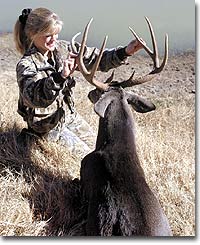
Bobbie Fain took this “black” buck, outside the usual range of the melanistic deer, on the Rancho Encantado in Dimmit County, Texas, in 1997. Most melanistic deer live in Texas, with the highest number being around 150 miles northeast of this ranch. Photo by Gordon Whittington.
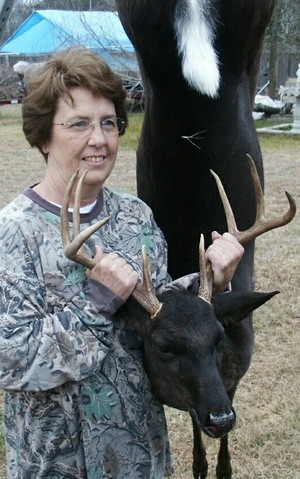
Woman with Central Texas black buck, 2004.
2. Western Slope near Loma, Colorado.
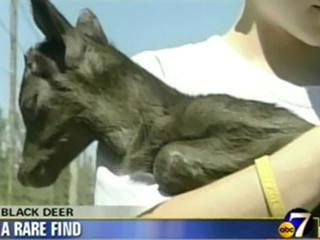
Colorado’s baby black deer, June 2005.
3. Bucks County, Pennsylvania.
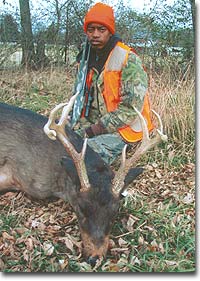
Andrew Hargrove shot this rare melanistic buck in Bucks County, Pennsylvania, in 2002. Photo by Roger Hayslip.
4. Winnemucca, Humboldt County, Nevada.
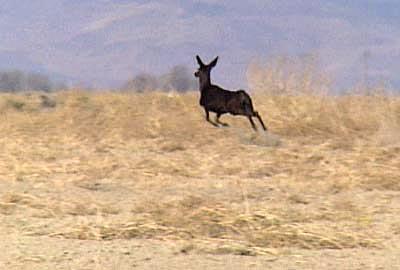
In November 2007, sightings of a black mule deer (above) in the area around the county seat of Humboldt County, Nevada, were reported by the Nevada Department of Wildlife.
5. Southern Wisconsin.
To round out the list, it needs to be mentioned that there are random sightings of melanistic deer in various southern (e.g. Mississippi), eastern (e.g. Pennsylvania), and midwestern (e.g. Indiana) states. But for a longterm record of black deer outside of the West, look to an academic paper documenting black deer from Wisconsin.
W. Chris Wozencraft authored “Melanistic Deer in Southern Wisconsin” for the Journal of Mammalogy, Vol. 60, No. 2 (May, 1979).
Wozencraft detailed various cases, including, for example, a sighting by Mr. and Mrs. A. P. Dobbe of a pure black deer near Sayner, Wisconsin, on September 10, 1948.
In what locations and areas in North America have you noted melanistic white-tailed or mule deer?
++++++
For the hyperlink to “The Top Ten Cryptozoology Stories for 2007,” please click here.
Brought to you by the….

About Loren Coleman
Loren Coleman is one of the world’s leading cryptozoologists, some say “the” leading living cryptozoologist. Certainly, he is acknowledged as the current living American researcher and writer who has most popularized cryptozoology in the late 20th and early 21st centuries.
Starting his fieldwork and investigations in 1960, after traveling and trekking extensively in pursuit of cryptozoological mysteries, Coleman began writing to share his experiences in 1969. An honorary member of Ivan T. Sanderson’s Society for the Investigation of the Unexplained in the 1970s, Coleman has been bestowed with similar honorary memberships of the North Idaho College Cryptozoology Club in 1983, and in subsequent years, that of the British Columbia Scientific Cryptozoology Club, CryptoSafari International, and other international organizations. He was also a Life Member and Benefactor of the International Society of Cryptozoology (now-defunct).
Loren Coleman’s daily blog, as a member of the Cryptomundo Team, served as an ongoing avenue of communication for the ever-growing body of cryptozoo news from 2005 through 2013. He returned as an infrequent contributor beginning Halloween week of 2015.
Coleman is the founder in 2003, and current director of the International Cryptozoology Museum in Portland, Maine.










Loren: you may just have ID’d for me the biggest animal I ever saw that I was unable to identify.
On a four-day backpack of the Foothills Trail on the NC/SC boundary in 2000 (I was in SC), the trail ran over a berm late in the afternoon. As I walked it, something big flushed down below, to my left. It was narrow through the shoulders, black, with prominent ears. There’s no question that it was a wild animal. I saw it for less than five seconds, looking down essentially onto its back, but never got a good enough view to be sure what it was. The size brought it down to four possibilities: wild boar; black bear; melanistic whitetail; sasquatch.
OK, kidding about the fourth.
I’d considered melanistic whitetail to be unlikely in the extreme, even though, of the possibilities, that’s what it looked like the most! In fact, this is the first I’ve heard of them, although it didn’t seem to me likely that melanism was unknown in this species (after all, it can be found in other deer). It might be the unfamiliarity of the “search image,” and nothing else, that had me wondering what it was. (I didn’t see the tail go up, which is interesting but no disqualifier.)
So add that area to your list. For black deer and hiking. For solitude and fine forest, the Foothills Trail is tough to beat. It’s an ecological crossroads, where northern and southern animals and plants can be found (I saw giant yucca and an anole. And the biggest wild brook trout I’ve seen. And fireflies, in April.) And the longest of its several footbridges is possibly the prettiest manmade structure I’ve seen in the woods.
I went to the area outside Winnemucca when I first heard of the melanistic mule deer.
We spotted one through a pair of binoculars. It was very neat to say the least. We don’t get much cryptid stuff around here except Tahoe Tessie and the occasional report of a Bigfoot near Truckee, California.
Melanistic deer are very unusual, and it would be startling to run across one suddenly in the wild. I wonder if some “black panther” sightings might be melanistic deer. Sure, deer don’t look much like panthers, but if someone just caught a fleeting glimpse of a large fast-moving black wild animal, they might think “Panther!” before they think “Deer!”
“…if someone just caught a fleeting glimpse of a large fast-moving black wild animal, they might think “Panther!” before they think “Deer!””
kittenz: as you can see, something like that might be what happened to me. 🙂
The lack of cougars keeping step in population increase along with the deer (or as farmers are starting to call them, “big rats”, could allow individuals with two recessive genes to survive and reproduce, where a balanced ecosystem would result in their becoming lunch at a young age.
If they were mostly in northern Iowa and southern Minnesota, I could see a survival advantage in camouflage on plowed fields. But that isn’t where they are showing up (S. Wisconsin being the closest example, and that being in the driftless zone, most likely, not the same as the prairie)
Black Deer should not be harvested. why kill a rare Animal?
Maybe they are being driven out of their habitat, SSCHAPER?
I don’t know—I’m not knowledgeable enough about melanistic deer to know what their proper habitat is.
Just a guess.
Great story, though, DWA.
I agree with bob michaels. I don’t understand the “ohhh it’s different let’s shoot it!” mentality.
Where is the squirrel post located?
In the city I grew up in, in Northern Kentucky, you had just as much a shot of seeing a black squirrel as you did a grey one. I am not exagerrating. My friends from Ohio were always amazed by this.
Underlined, gray items in these blogs are hyperlinks. Click on them to forward yourself to noted topics.
Therefore, the “melanistic squirrels” phrase above is a hyperlink, and you get to that post by clicking on it.
Sorry about that Loren. The first couple times that I hit the links it took me to a circuit city page. That’s why I asked. It seems to be working fine now.
Here is a link to an article on my area.
http://www.woodlandhabitat.com/articles/black-squirrels.htm
I grew up in Lakeside Park, but all the cities mentioned are bordering each other in Northern Kentucky, and considered part of the “Greater Cincinnati” area, though the black squirrels do not seem to make it across the river to the actual Cincinnati city limits.
A melanistic deer may be a rare animal, but it is a genetic mutation, not a separate species, so killing one is not the same as killing an endagered or rare species.
Taking Saint Vitus’s comment a bit further:
Killing only non-melanistic members of a species, if taken to its logical extreme, could well lead to the melanistic becoming the common and the non-melanistic the rare ones!
As a hunter(oooh), I would definitely kill a black deer or an albino deer. I’m not saying that “its different so lets shoot it” mentality is a good one but when it comes to deer I think it’s fine. There are hundreds of thousands of deer on this continent, if not millions, and there will always be genetic mutations within the species whether its a melanistic deer or an albino deer. The fact of the matter is that the colouring makes it different and more desirable. It would be a nice trophy and something you could always talk about with family, friends, and others. By killing it, you are not harming the well being of the species in any way. DWA makes a very good point about killing the non melanistic deer and and the melanistic deer becoming the norm. Now I know lots of you probably don’t agree with killing animals for sport or any other reason, except maybe self defense, but I’m not here to say hunting is good, everyone is entitled to their own opinion even if it’s wrong lol. I just thought I would give my two cents because I am a deer hunter. One more question for everyone though. If we shouldn’t shoot “rare” deer, should we not shoot a sasquatch because they are rare or possibly endangered. Yes we should! But only one and only because science demands it. We all know that is the only ways the scientific community will accept it. Film, photos, and audio will never be enough. That was proven when the PGF was dismissed over and over again. Just something to ponder over.
I am from Beaverdam Virginia. We have a very old buck here that no one has killed so far. He lives on my mom’s farm. 6 miles from me. He is dark black and silvery grey. He is called Old Ironsides.
Last night my brother was driving home and saw a black young buck with another brown buck and two other deer (females). All were very young. They also had a beagle walking with them along the side of the road. This was less than ONE mile from our home. In between my my mothers property and mine is a 2,200 acre hunting reserve.
So I tried to research black deer and stumbled upon “melanistic whitetail deer”.
So at least one but maybe two melanistic deer live in our area.